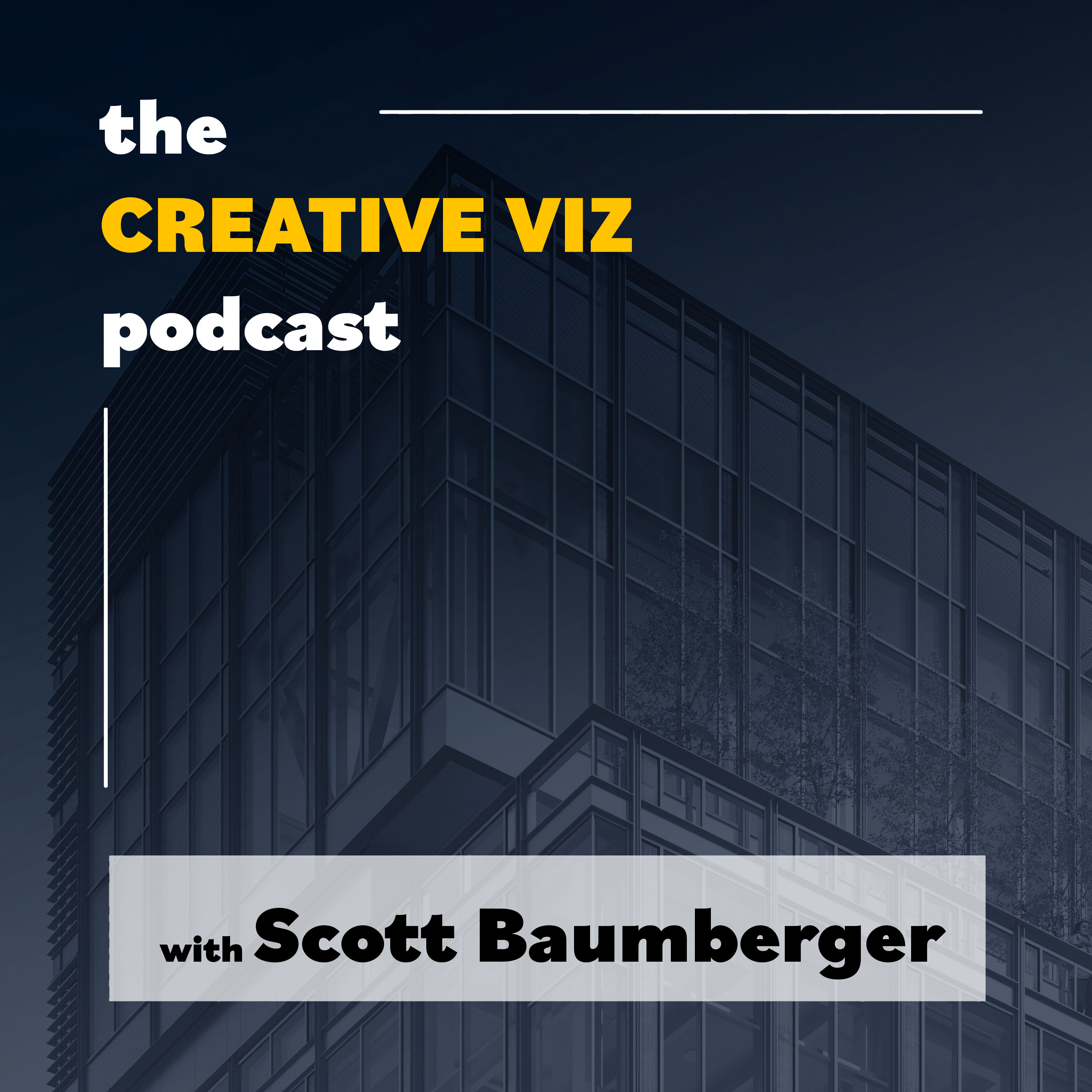

Rendered Reality: The Blend of Artistry and Technology in Archviz.
The Creative "Viz"
| Scott Baumberger | Rating 0 (0) (0) |
| www.apex-visualization.com | Launched: Oct 20, 2023 |
| scott@apex-visualization.com | Season: 1 Episode: 1 |
Dive deep into the transformative world of architectural visualization with the Creative Viz podcast. In this riveting episode, uncover the historic roots of Archviz and its journey from the Middle Ages' intricate hand-drawn plans to today's cutting-edge photorealistic renderings. Discover how breakthroughs like real-time rendering and AI are reshaping the way architects and developers present their visions. As the Archviz industry continues to evolve, blending cinematic techniques and storytelling, learn about its significance in project development stages. Whether you're an architect, a developer, or just an enthusiast of design and visualization, this episode promises a comprehensive exploration into the art and science of Archviz. Don't miss this chance to step into the future of architectural presentation!
Follow Scott on LinkedIn: Scott Baumberger
Want Apex Visualization to help you? APEX
SUBSCRIBE
Episode Chapters

Dive deep into the transformative world of architectural visualization with the Creative Viz podcast. In this riveting episode, uncover the historic roots of Archviz and its journey from the Middle Ages' intricate hand-drawn plans to today's cutting-edge photorealistic renderings. Discover how breakthroughs like real-time rendering and AI are reshaping the way architects and developers present their visions. As the Archviz industry continues to evolve, blending cinematic techniques and storytelling, learn about its significance in project development stages. Whether you're an architect, a developer, or just an enthusiast of design and visualization, this episode promises a comprehensive exploration into the art and science of Archviz. Don't miss this chance to step into the future of architectural presentation!
Follow Scott on LinkedIn: Scott Baumberger
Want Apex Visualization to help you? APEX
Hello, and welcome to the Creative Viz podcast, where we're going to dive into topics related to architecture, development, and visual design. In this episode, we're going to discuss the high level subject of architectural visualization itself. That's Archviz. What exactly is this, and why do I need to know about it?
Archviz is simply the method of communicating To any stakeholders, what a proposed new building or renovation might look like. This has a historical basis going back to fact, all the way back to the middle ages, when the master craftsmen would draw plans for cathedrals that might take hundreds of years.
They had the vision and they needed to be able to communicate it to the community. And then also to the people who were going to be. Building the structure, in some cases, many years after they were gone. When we think about architectural visualization, this is a relatively new industry as it exists today.
It really only dates back to about the mid 90s or so. As I mentioned, it is rooted in traditional architectural design and illustration. The growth of the industry has been very closely tied with the development of photorealistic rendering software.
Today, the leaders would be V Ray, Corona. , as well as real time engines such as Unity, Unreal Engine and emerging options such as Twinmotion and Vantage. In the early days of ArcViz, renderings were quite crude. They relied heavily on very basic 3D models, oftentimes were hybrid renderings, that is, mixed computer and hand drawn illustrations to create final renderings.
As the software evolved and became more powerful, New opportunities opened up a big one in the early 2000s was the development of global illumination. this rendering method calculated bounce light and made renderings much more realistic, much more lifelike and true to photography.
That was a big turning point for the industry. And we're in the midst of another big turning point as not only real time rendering is taking hold, But also the emergence of AI, as in so many other creative fields, is starting to change how Archviz artists create images and also how they're conceived from the beginning.
That's a big topic. I think we're going to save that one for a later one. But important to know that the industry is definitely a state of transition. The other thing I want to mention about Archviz is that as the industry has evolved, it used to be primarily done within design firms.
Say an architect would be responsible for the design, the development, the construction drawings, and also the rendering, communicating the design. As the software matured, it takes longer to create the renderings. So the field became much, more specialized.
And that's where, the notion of an Archviz consultant specialist really came into being. The nature really of Archviz has continued to evolve to include styles and rendering techniques that might've been formerly associated with Hollywood.
Things like cinematic framing, storytelling, the use of live actors against a green screen, and special effects, VFX like pyrotechnics, water simulation. Particles. All of these used to be very much in the domain of high end, industrial light and magic type companies. And of course, now these are well within the reach of even smaller Archviz companies.
These techniques are really specialized and much more than, architects, designers. Can, normally account for in their design effort. So it makes a lot of sense to hire an outside consultant at certain points during the project, when it's important to communicate the design. These typically come early phase, something like, well, they're, they're going to be a couple of different scenarios for early phase development.
That's going to be potentially pre award like an architectural competition. Sometimes it's useful to bring in a consultant to help. With the, rendering conception and design, sometimes a fresh eye can, make all the difference in winning or not winning that competition. That's certainly one common scenario.
The next one, as the project would move forward and it's lifespan. Would be internal or community review, design approvals, things of this nature.
That can, that can be internal to financial stakeholders. And then potentially that, could also encompass design review boards, city councils. This is the, oftentimes the first time the public has a chance to review the project and critical that as a developer, you're putting your best foot forward.
And very commonly point in time when you want to bring in a specialist that can create these high end visuals, something that might not be good enough if you were just to take something off the boards, as it were, from from a creative, as you move forward through the process, a large project may have.
Some visualization needs as you go, particularly for interiors. These high end visualizations can be used to test certain aspects of the design. And this starts to touch on another topic we're gonna delve into a little bit later. That is the digital twin concept. , there's a pretty big overlap between ArcViz and digital twins.
So, like I said, we'll get into that. Those tend to be mid phase and then as the project, continues to move forward, potentially point of groundbreaking, this is where marketing campaigns, sales, leasing efforts begin, and it's very important to have your highest quality visualizations at this point.
To not only explain and communicate the concept, but truly to sell it to, your stakeholders are going to be first at, let's say, a residential project, maybe buying their home. And so it's very important that they understand what this project, their home is going to look like even before it's built.
That can help speed up sales, save a lot of money in terms of financing and approvals there. As you move over to the commercial side, it's also important to. Accelerate leasing efforts. It's a very competitive environment, and, these visuals can make or break a leasing campaign, say, for a shopping center or retail space.
If you're looking to attract tenants, they often want to know what this project is going to be like. Well in advance of occupancy and of course the owners want to have deals in place well ahead
So as I mentioned arcvis has really matured and this is has come to encompass renderings But multimedia examples and all the way up the range to full fledged short films Many studios are creating Short marketing films as part of the sales campaign to generate interest intrigue for an upcoming project.
And, these not only are incorporating some of the things that we may have formerly associated with Hollywood, but they're introducing concepts like storytelling, marketing. And sales into the campaign. This is, another emerging field for archivist artists and studios.
This is another avenue that owners, developers, stakeholders should consider for larger projects, really generating high quality visuals for outreach to potential buyers and community stakeholders.
That's a really high level overview of what Archviz is all about. Hopefully that's been helpful. Like I said, we're going to continue to explore some of these topics in more depth with later episodes, but for this week, I think that's going to be it. Thank you so much for listening. Be sure to like, and subscribe to stay on top of all the latest developments and I will see you next time.


